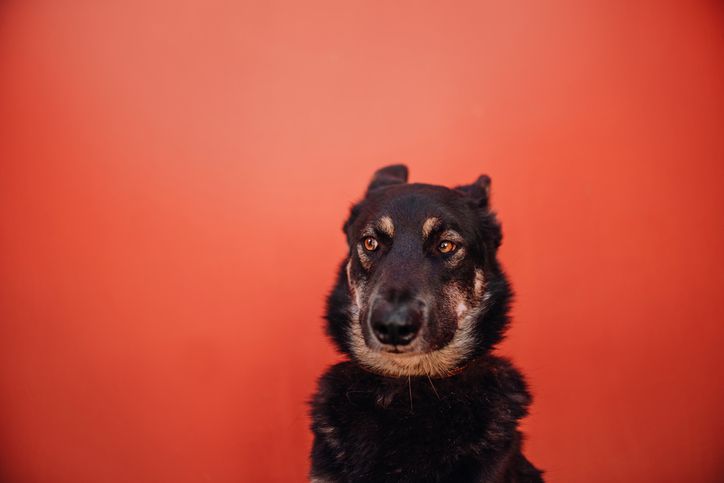Dogs put their ears back to show submission or fear, as it is a way of expressing their emotions. When a dog feels threatened or anxious, it often pulls its ears back as a defensive gesture.
This behavior is an instinctual response to perceived danger or a dominant presence. By flattening their ears against their heads, dogs try to appear smaller and less threatening to others. Understanding and respecting these signals is essential, as they help establish a stronger bond with our furry friends.

Understanding Dog Body Language
UnderstandingUnderstanding: When communicating with other dogs or humans, dogs return their ears as a sign of submission or fear. By understanding this body language, you can better interpret your dog’s emotions and create a safe and positive environment.
Importance Of Understanding Dog Body Language
How Dogs Communicate Through Body Language
Signs Of Stress And Anxiety In Dogs
Understanding dog body language is crucial for any pet owner. Dogs have a unique way of communicating through their body language, and it’s essential to interpret their signals accurately. Understanding their subtle cues can better meet their needs and ensure their well-being.
Importance Of Understanding Dog Body Language
It is vital to comprehend dog body language to foster a strong bond with your furry friend. Dogs primarily communicate through non-verbal cues such as facial expressions, tail wagging, and ear positions. Observing and understanding these signals can help you better understand your dog’s emotions and respond appropriately. This understanding also helps prevent unwanted behaviors and establish a positive relationship based on trust and empathy.
How Dogs Communicate Through Body Language
Dogs use their entire body to communicate their feelings and intentions. Their most expressive features include their ears, tail, eyes, and stance. You can gain valuable insights into their emotions by observing their ear movements. When dogs put their ears back, it often indicates fear, submission, or anxiety. This could be their way of signaling that they are uncomfortable in a particular situation. It’s essential to assess the overall context, including other body language cues, to accurately interpret the message they are trying to convey.
Signs Of Stress And Anxiety In Dogs
Stress and anxiety can manifest in various ways, and it’s crucial to identify these signs early on. When dogs are stressed or anxious, they may display behaviors such as flattened ears, panting excessively, trembling, or pacing. Additionally, they may exhibit avoidance or submissive behaviors, such as tucking their tail between their legs or cowering. Attention to these cues is essential to providing support and creating a calming environment for your canine companion.
Your Role In Ensuring Your Dog’s Well-being
As a responsible pet owner, you must prioritize your dog’s well-being. This starts with understanding their body language and being able to identify signs of stress and anxiety. By recognizing these signals, you can take the necessary steps to alleviate their discomfort and provide a safe and comforting environment. Consulting a professional dog trainer or behaviorist can be helpful in understanding and addressing any behavioral issues that may arise.
In Conclusion
Understanding dog body language significantly fosters a strong and healthy relationship with our furry friends. By staying attuned to their signals, we can ensure their well-being, prevent potential issues, and create a loving and harmonious home environment. Remember, your dog’s body language communicates with you, so pay attention and respond with care and understanding.
Why Dogs Put Their Ears Back
When understanding our furry friends, every little behavior has a story. One of the dogs’ most noticeable and intriguing behaviors is putting their ears back. While it may seem like a simple action, there’s much more behind those floppy or perky ears. In this article, we’ll explore why dogs put their ears back and what those different ear positions mean in their unique language of communication.
The Role Of Ears In Dog Communication
A dog’s ears play a crucial role in communicating with other dogs and humans. Dogs can move their ears in various positions, reflecting their emotional and mental states. By observing a dog’s ear position, we can gain insights into their current mood and level of comfort. Understanding this silent language is critical to building a solid and meaningful bond with our canine companions.
Different Ear Positions And Their Meanings
Dogs can display a range of ear positions, each conveying a different message. Let’s explore some common ear positions and their corresponding meanings:
| Ear Position | Meaning |
|---|---|
| Straight up and forward | The dog is alert and focused. |
| Tilted or half-forward | The dog is listening intently and is curious about its surroundings. |
| Relaxed and slightly to the side | The dog is at ease and content. |
| Back and close to the head | The dog is displaying fear, submission, or anxiety. |
There can be several reasons why a dog might put their ears back, and it’s essential to pay attention to the overall body language to interpret the meaning accurately. Some of the common reasons include:
- The dog is fearful or anxious, indicating a need for reassurance and comfort.
- The dog is displaying submission to a dominant individual or avoiding conflict.
- The dog is experiencing physical discomfort or pain, causing them to retract their ears to protect them.
- The dog is overwhelmed or stressed by a particular situation, leading to an instinctual response of putting their ears back for self-preservation.
Understanding why dogs put their ears back helps us better comprehend their emotions and responses. It allows us to provide the appropriate support and care they need in different situations. It’s important to remember that each dog is unique. While general interpretations are helpful, observing specific contexts and individual personality traits is crucial to understanding our canine companions.
Interpreting Other Dog Body Language Signals
Dogs communicate using a combination of verbal cues, body movements, and facial expressions. By understanding these signals, we can better comprehend their emotions and intentions. This article will explore three essential components of dog body language: tail position, eye contact, and posture. These signals can provide valuable insights into a dog’s behavior and mood, helping us create a safe and harmonious environment for our four-legged friends.
Tail Position And Its Significance
A dog’s tail can provide valuable insights into their emotional state. Understanding the meaning behind different tail positions can help us interpret their intentions and reactions. Here are a few common tail positions and their significance:
| Tail Position | Significance |
|---|---|
| High and curved over the back | A dog with a high and curved tail often expresses confidence and alertness. They may be interested or excited about something in their environment. |
| Straight and horizontal | A straight and horizontal tail usually indicates a calm and relaxed state. This position is commonly seen when a dog is at ease and content. |
| Tucked between the hind legs | A tucked tail suggests fear, anxiety, or submission. It indicates that the dog feels threatened or uncomfortable in a particular situation. |
Eye Contact And Its Meaning
Eye contact is another crucial aspect of dog body language. It can convey a range of emotions and intentions. Let’s explore the different meanings behind eye contact with dogs:
- Maintained eye contact: Dogs often establish eye contact to show confidence and assertiveness. It may also indicate a challenge or a desire to assert dominance.
- Avoidance of eye contact: When a dog avoids eye contact, it can signify submissiveness, fear, or uneasiness.
- Soft, relaxed gaze: A quiet, simple gaze indicates trust and security. It suggests that the dog feels comfortable in their current environment.
- Starting with a fixed gaze: Dogs may stare with a fixed gaze when they are focused or alert. This can be observed when they are intensely interested in something.
Posture And Stance In Dogs
A dog’s posture and stance provide additional clues about their emotional state. Here are some common postures and what they usually indicate:
- Relaxed posture: A dog with an open posture is often content, calm, and comfortable in their surroundings.
- Stiff, upright stance: A rigid stance can indicate alertness or aggression. It suggests that the dog is prepared for action or maybe feeling threatened.
- Head lowered: When a dog lowers its head, it is often a sign of submission or feeling anxious.
- Head held high: Holding the head high expresses confidence and assertiveness. It can be seen in dominant dogs or those looking for potential obstacles or threats.
We can gain valuable insights into a dog’s body language by observing its tail position, eye contact, and posture. When interpreted correctly, these signals enable us to respond appropriately and create a positive and harmonious relationship with our furry companions.


Frequently Asked Questions For Why Dogs Put Their Ears Back
Why Do Dogs Put Their Ears Back?
Dogs put their ears back as a sign of fear, submission, or discomfort. It is a way for them to communicate their lack of aggression or concern. By putting their ears back, dogs are attempting to make themselves appear smaller and less threatening to others.
Can I Train My Dog To Keep Their Ears Up?
It is possible to train your dog to keep their ears up, especially if they have ears that are naturally floppy. Regular ear exercises, such as gently rubbing the base of their ears, can help strengthen the muscles that hold the ears up.
However, consulting with a professional dog trainer or veterinarian is essential before attempting any training techniques.
Are There Any Medical Reasons For A Dog’s Ears To Be Back?
While it is common for dogs to put their ears back as a natural behavior, there are also medical reasons why a dog may hold their ears back. Ear infections, allergies, or injuries can cause discomfort and inflammation, leading to a dog holding their ears in a different position.
If you notice your dog consistently holding their ears back, it is best to consult with a veterinarian to rule out any medical issues.
Conclusion
Understanding why dogs put their ears back is crucial for owners to communicate effectively with their furry companions. We can better understand their emotions and needs by paying attention to their body language and situational cues. This knowledge allows us to build stronger bonds, provide appropriate care, and create a safe and comfortable environment for our four-legged friends.
So, let’s keep observing and decoding their ear movements to ensure their happiness and well-being.
